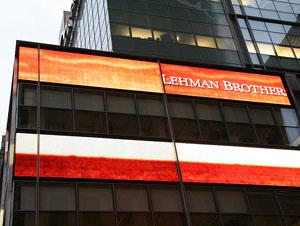The fate of Lehman Brothers’ art
(image: Flickr user Brian Einarsen (cc: by-nc-sa))
When people aren’t working people aren’t spending. And when people aren’t spending people aren’t selling. These facts of life are all too obvious in today’s art market.
The BBC’s art correspondent Lawrence Pollardfi prepared this report for PRI’s “The World.”
In September last year, one of the most successful contemporary art auctions of all time took place. Artist Damien Hurst sold $200 million worth of art all in one go. The art market had never seen a boom like it.
And strangely, it was on the very same day that the decision by Lehman Brothers to file for bankruptcy was on the news.
Slowly the art market, followed all other markets went into a collapse — especially the type of art beloved of bankers: the cutting edge trendy stuff called post-war contemporary.
“We’ve seen paintings go for half of what they’d fetched a few years ago,” says Georgina Adam, art market editor for the “Art Newspaper” and the “Financial Times.”
“Sotheby’s and Christies reported drops of 50 percent, 60 percent, even 70 percent compared to the previous year,” Adam added. “Particularly the market for post-war and contemporary art has really seen a massive drop. It had a great appeal to people with a lot of money, people with new money, and that really is the part of the art market that has been hit the most. It has dropped catastrophically really. The sales have turned in totals that were perhaps 20 percent or 30 percent of the totals that were made a year ago.”
Banking and art have always gone together like love and marriage. For example, there is the Robert Lehman collection in New York’s Metropolitan Museum of Art. The former CEO of Lehman’s, Richard Fuld, was a respected art collector. His wife, Kathy Fuld, was a trustee of the Museum of Modern Art. Together they sold $13 million worth of art just a few months ago. And of course Lehman’s had its own corporate collection. Now just as you can buy Lehman’s baseball caps and pens on E-bay soon you’ll find part of the Lehman art collection for sale.
Ann Henry is from Freeman’s Auctioneers in Philadelphia, where some of the Lehman Brother’s art is to be sold in a few weeks time for — it’s hoped — over a million dollars.
“Everything was hanging in various Lehman Brothers’ offices in New York, Boston, and Delaware. The stuff in the corridor; the stuff in the board room; individual offices. The company had a very important significance in the history of our country and I think their collection reflects that,” says Henry.
Not all the collection is being sold. Neither Lehman’s, the liquidators, nor their art consultant would give an interview, so it’s unclear which pieces are being kept back.
According to Georgina Adam, this is a bad time to hold a sale, “As with all assets when you have to sell it’s not worth as much as was when you bought it. And then of course when the hard times come, all of a sudden it’s sort of looked at as an asset and something that can be realized to make some money.”
However, recent events can also add interest. Coming up for sale is a print of the New York Stock Exchange. The print used to belong to Lehman Brother’s, who caused the stock exchange to crash — so who wouldn’t enjoy that irony up on their wall?
“That will be interesting to see,” says Henry. “I’m curious to see the result of that as well. I think we’ve had a tremendous amount of interest in the sale already from a lot of people in the finance industry. So I’m very curious to see what prints of this theme do in the sale.”
The auctions of Lehman Brothers’ art begins on the first of November.
PRI’s “The World” is a one-hour, weekday radio news magazine offering a mix of news, features, interviews, and music from around the globe. “The World” is a co-production of the BBC World Service, PRI and WGBH Boston.
